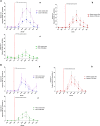Large-scale field trial of attractive toxic sugar baits (ATSB) for the control of malaria vector mosquitoes in Mali, West Africa
- PMID: 32059671
- PMCID: PMC7023716
- DOI: 10.1186/s12936-020-3132-0
Large-scale field trial of attractive toxic sugar baits (ATSB) for the control of malaria vector mosquitoes in Mali, West Africa
Abstract
Background: The aim of this field trial was to evaluate the efficacy of attractive toxic sugar baits (ATSB) in Mali, where sustained malaria transmission occurs despite the use of long-lasting insecticidal nets (LLINs). ATSB bait stations were deployed in seven of 14 similar study villages, where LLINs were already in widespread use. The combined use of ATSB and LLINs was tested to see if it would substantially reduce parasite transmission by Anopheles gambiae sensu lato beyond use of LLINs alone.
Methods: A 2-day field experiment was conducted to determine the number of mosquitoes feeding on natural sugar versus those feeding on bait stations containing attractive sugar bait without toxin (ASB)-but with food dye. This was done each month in seven random villages from April to December 2016. In the following year, in seven treatment villages from May to December 2017, two ATSB bait stations containing the insecticide dinotefuran were placed on the outer walls of each building. Vector population density was evaluated monthly by CDC UV light traps, malaise traps, pyrethrum spray (PSCs) and human landing catches (HLCs). Female samples of the catch were tested for age by examination of the ovarioles in dissected ovaries and identification of Plasmodium falciparum sporozoite infection by ELISA. Entomological inoculation rates (EIR) were calculated, and reductions between treated and untreated villages were determined.
Results: In the 2-day experiment with ASB each month, there was a lower number of male and female mosquitoes feeding on the natural sugar sources than on the ASB. ATSB deployment reduced CDC-UV trap female catches in September, when catches were highest, were by 57.4% compared to catches in control sites. Similarly, malaise trap catches showed a 44.3% reduction of females in August and PSC catches of females were reduced by 48.7% in September. Reductions of females in HLCs were lower by 19.8% indoors and 26.3% outdoors in September. The high reduction seen in the rainy season was similar for males and reductions in population density for both males and females were > 70% during the dry season. Reductions of females with ≥ 3 gonotrophic cycles were recorded every month amounting to 97.1% in October and 100.0% in December. Reductions in monthly EIRs ranged from 77.76 to 100.00% indoors and 84.95% to 100.00% outdoors. The number of sporozoite infected females from traps was reduced by 97.83% at treated villages compared to controls.
Conclusions: Attractive toxic sugar baits used against Anopheles mosquitoes in Mali drastically reduced the density of mosquitoes, the number of older females, the number of sporozoite infected females and the EIR demonstrating how ATSB significantly reduces malaria parasite transmission.
Keywords: ATSB; Anopheles gambiae; Mali; Sugar feeding; Vector control.
Conflict of interest statement
The authors declare that they have no competing interests.
Figures




References
-
- WHO . World malaria report 2018. Geneva: World Health Organization; 2018.
MeSH terms
Substances
Grants and funding
LinkOut - more resources
Full Text Sources
Medical
Miscellaneous

